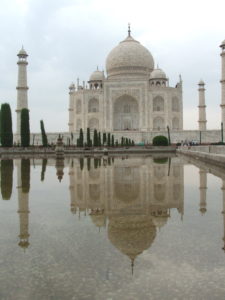
Most visitors to India start with the Golden triangle tour. It encompasses the cultural and historical splendor found in the cities of Delhi, Agra with the Taj Mahal and royal Jaipur. These three cities are well connected by road and rail. Delhi to Agra is about 4 hours by road and Agra to Jaipur is about 3 hours, although city traffic may make it longer.
We landed in Delhi and chose to visit these cities by road using a hired car transfer with driver. When traveling by road, it is advisable to travel during the day only for safety reasons. We left after an early lunch from Delhi, reached Agra in the evening before sunset and stayed just 1 night in Agra.
Agra
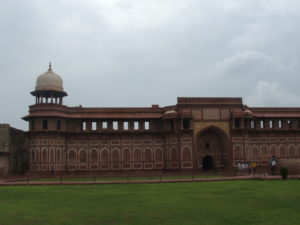
Agra as a city is crowded, chaotic and sadly I have to admit ugly except for its one truly bright spot – the Taj Mahal and the nearby Agra Fort. We visited the Taj Mahal first thing early morning at 6.30 am as soon as it opened and we were so glad. For one it was not hot early morning and second the tour groups and crowds had not arrived so we could enjoy the place in peace.
Words cannot describe the beauty of the Taj. It looks exactly as it does in the pictures but this monument of love built by Emperor Shah Jahan in memory of his wife, impresses you with its purity. Poet Rabindranath Tagore described the Taj as ‘a teardrop on the cheek of eternity’ and you will be ever so glad when you see it in person. When you walk through the gates and see the symmetrically laid out pools with the reflection and the Taj itself up ahead, it’s quite stunning. The perfect symmetry of the white marble mausoleum and the intricate work seen on the marble inside will take you back to another world. You cannot take large bags or food or drink inside and it is closed for prayers on Fridays.
You may be bothered by photographers but the one we gave into did a really good job and within the hour we had pictures printed and ready for us to take as we left. We then visited the Agra Fort built by Emperor Akbar. Entry fees for foreigners are much higher than for Indians and your Taj ticket may include entry to the Agra Fort as well.
Accommodation options in Agra are many and include these:-
- ITC Mughal, high end luxury in close proximity to the Taj and the only Indian hotel to be the recipient of the Aga Khan Award for architecture
- The Gateway Hotel run by the Taj group (where we stayed and highly recommend)
- Trident
- Jaypee Palace Hotel
Jaipur
The capital of Rajasthan is the first planned city of India. This princely city also called the Pink City deserves at least 3 nights to truly experience its royal majesty. We loved Jaipur and some of the main attractions in Jaipur are listed below:-
Amber Fort
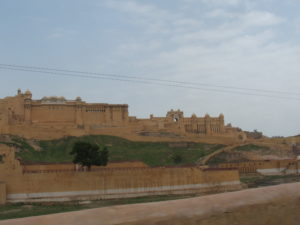
Amber fort set high on a hill is an impressive sight and takes you back to a different era. You approach the complex by walking or by riding an elephant. Built by Raja Man Singh I in the late 16th century, the fort combining Rajput and Mughal architecture is made of red sandstone and white marble. This is a must visit attraction in Jaipur.
Jaigarh Fort
Down the road, is JaiGarh Fort, home to the largest canon in the world – the views from this fort are fantastic. Reputed to be the most magnificent of the three hilltop forts that overlook the city of Jaipur, Jaigarh was built by Sawai Jai Singh II sometime in the early 18th century.
Jal Mahal
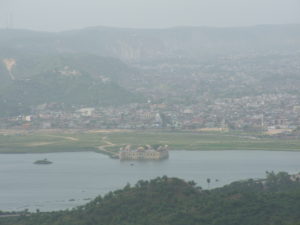
From the ramparts of the JaiGarh Fort, you can see the beautiful Jal Mahal or Lake Palace, which appears to float in the centre of Man Sagar Lake with its light, sand colored stone walls set off against the blue of the water. Originally built as a summer retreat for royal parties or hunting trips, it actually has 5 levels, 4 are submerged under water. It is now an abandoned place and cannot be visited, so simply enjoy the exterior view from afar while going or coming from the Amber Fort.
Jaipur City Palace
The City Palace, built by Maharaja Sawai Jai Singh II also blends Mughal and Rajput styles and the royal family continues to reside in one section of the palace. The musuem houses royal wardrobes, fabrics from yesteryears as well as ammunition in the armory.
Hawa Mahal
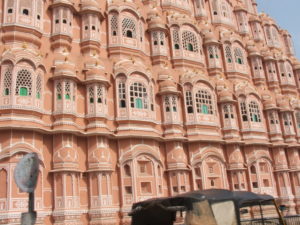
The Palace of Winds, adjacent to the City Palace, was constructed in 1799 by the poet-king Sawai Pratap Singh. The five-storied structure, made of pink sandstone has 356 intricately carved jharokhas or windows and looks grand on the outside but there is not much to see on the inside. It was years ago designed for the women of the royal family to sit in privacy while observing life on the street. The façade is gorgeous but at the back it’s just a narrow hall wide. The design of chiseled lattice screens allowed for a soft breeze or Hawa to flow freely through allowing the royal ladies both privacy and comfort. Today the complex houses the Archaeological Museum and administrative offices.
Albert Hall Musuem
Sir Swinton Jacob, who also architected several other palaces in Rajasthan, designed Albert Hall using the Indo-Saracenic style. The Prince of Wales laid the foundation stone of the building in 1876. The exquisitely built Albert Hall is a museum that has a good collection of Indian artifacts from the region.
Other attractions to visit if you have more time include:-
- Nahargarh Fort, meaning ‘abode of the tigers’, built in 1734 by Jai Singh
- The Jantar Mantar which is the largest of the five astronomical observatories built by Maharaja Sawai Jai Singh II, the founder of Jaipur
- The Ranthambore National Park, 100 miles south of Jaipur – known for its tiger and leopard sightings
While in Jaipur shop at Anokhi for clothes and Rajasthali, the government run handicraft emporium. Jaipur is also known for its Blue pottery and tribal jewelry. Rajasthani Khazana, Jaimahal Palace, has some of everything.
Accommodation options in Jaipur include the Jai Mahal Palace hotel run by the Taj group which is where we stayed for 3 nights. The Jai Mahal Palace hotel is a wonderful choice for a comfortable stay with a touch of the royal vibe. If you can splurge, choose the Taj Rambagh Palace. ITC Rajputana is another good reasonably priced hotel. There are several other options as well but it is better to stay within the city and closer to attractions.
Where to Eat in Jaipur
Natraj on MI Road. Highly recommend this restaurant and its excellent Rajasthani Thali.
Spice Court Restaurant
Umaid Bhawan restaurant in the Heritage hotel with a good view from the rooftop
Surya Mahal at The Oberoi Rajvilas Hotel: Luxury fine dining, considered a romantic place to have dinner in Jaipur.
Delhi
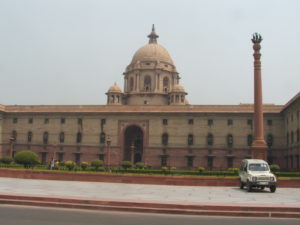
From Jaipur, we traveled by car back to Delhi. Since our trip was during July, the Delhi heat was unbearable and as a result we did not enjoy sightseeing in Delhi as much and mostly took it in from the car. The Jaipur heat at the time did not seem as bad as Delhi. We rushed through Qutub Minar and spent less than 5 minutes at the India Gate due to the oppressive heat. But if your visit is during a cooler month, then definitely you will find Delhi to be a charming city full of history and some colonial charm.
Some of the sites you would want to visit are Qutub Minar, Red Fort, India Gate, Rashtrapati Bhavan and Humayun’s tomb. Delhi also has interesting worship places like the Akshardham and Bahai temples. Dilli Haat is a tourism targeted area that sells arts and food from the different states of India and okay for an evening visit. If you have a local with you, prices can be bargained down better. Apart from the retail showrooms at Connaught Place, Delhi also has markets like Sarojini Nagar, Lajpat Nagar for bargain shopping.
Accommodation options in Delhi are many but what I find irritating in India is that in a culture where family is valued highly, hotels will not allow you to have one room with your children unless they are very young. In most cases the hotels insist that you take 2 rooms even if there is enough space in the room for an extra bed or two. The absence of the family room in hotels across India is something that needs to be addressed in my opinion.
Mystic India starts with the Golden Triangle, the equivalent of India 101. The circuit will not disappoint you but as with any travel, keep an open mind to another culture and be prepared for the traffic, chaos, dust and heat that is part of the fascinating conundrum that India represents.